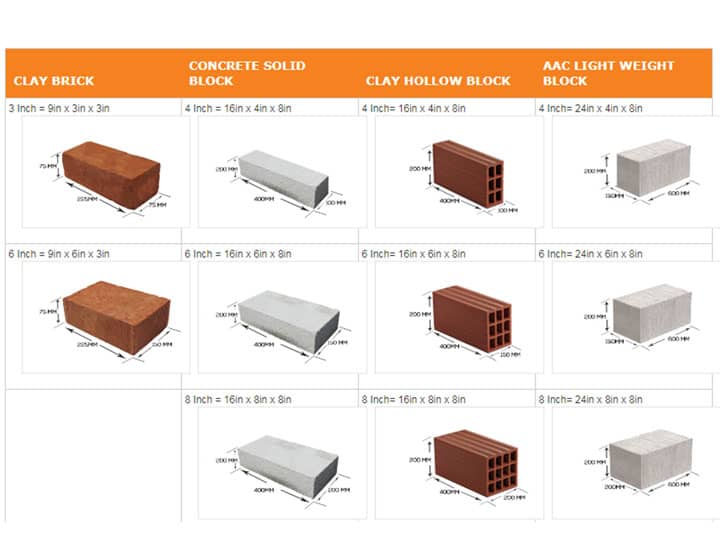One of the oldest building components ever used, clay bricks are the most well-known building blocks ever. These are made from burning clay cast in a rectangular shape and thus a crystalline ceramic is forms. Easy to make and sustainable, they are the most commonly used from the beginning of civilization.
Clay bricks are most commonly known simply as bricks, but they are also called Red bricks, Chamber bricks, Table mold bricks, Clay wire cut bricks etc. depending upon the origin and exact method of manufacture.
Generally, clay bricks are made of ? surprise, clay! That means wet soil. For additional qualities, you can mix sand, lime, natural concreting materials etc. into the clay as well. Dark reddish in color, different qualities of soil used as the clay would produce different qualities of bricks.
Bricks are generally 3 inches or 6 inches in size. The first type would weigh around 3 kgs or more, and the later would go slightly above 4.5 kgs, depending upon what material you used in them.
The best thing about bricks is that they are very much fire resistant, being born in fire themselves. Also, they are so low-maintenance that literally thousands of years old brick constructions are still standing these days.
Bricks can take about 2.5-3 N/sq.mm force. They have excellent load carrying capacity. You would need about 43 bricks to build something one square meter in size and 4 inches thick, costing you around 350 rupees.
Also called cement blocks, concrete solid blocks, masonry blocks, or more technically concrete masonry units (CMU's), these are rectangular blocks used in modern construction. They are appreciated mostly for the versatility of shapes and sizes they can be made in. Versatile and strong (with a 5 N/sq.mm compressive strength), they can be cast in literally any shape, according to the need of your architect.
A concrete block is made of, as the name suggests, concrete. That means you take sand, cement and aggregate and add water and mix. When set, you get the block. Since the quality of concrete depends upon the ratio of materials, the same principal applies in case of concrete blocks as well.
Reddish gray in appearance, they come in generally large blocks, reaching up to 8 inches in size weighing as much as 35 kilos each. This is harder to handle, but better to durability. Smaller (4 inches) blocks are also available which can be handles by humans.
Aside the versatility, CMU's are loved for their stability and durability. Because you are building directly out of concrete cemented together, you can rest assured that nothing short of major earthquakes or high-yield bombs can make a dent in your walls. Being the strongest kinds of building blocks available in market, they can carry immense loads and take the pressure off the columns if you build walls right on top of walls.
However, concrete is not cheap. Each block is painfully costly to create. However, since they are so large, you generally have to use very little of them, thereby reducing your overall total cost. A full square meter of 4" wall would only need like a dozen of concrete solid blocks, costing actually slightly less than bricks covering that much area.
The hollow clay blocks look much like hollowed out huge bricks, and are also called structural clay tiles or porotherm blocks. Created to be an upgrade over conventional bricks, these are made by mixing clay with coarse aggregate for greater durability and cement for better bonding, these are easier to produce, much lighter than the same-size cement blocks, and are very useful where heat insulation is very much needed.
Available in the same 4"/6"/8" variants in the markets, these blocks weigh from 6 to 12 kgs, depending upon size and design. The one downside of the clay hollow bricks is that they have no load bearing capacity to speak of. Their compressive strength is better than bricks but worse than concrete blocks (about 4N/sq.mm).
Being the same size, you would need the same number of hollow clay blocks to make a square meter wall as you needed concrete blocks. However, it will cost you substantially more, well over 450 rupees.
The acronym 'AAC' stands for Autoclaved Aerated Concrete and are also known as lightweight blocks. These are also a kind of concrete blocks, but much lighter and suitable for domestic construction. Flat grey in color, these are made from standard concrete materials like sand, cement and aggregates mixed with some lightweight material like fly ash and some kind of rising agent, like aluminum powder and lime. After the mix is set its baked under great pressure in an autoclave.
The unique property of AAC blocks is actually born when it is cast in structure. When it is set in a wall, the aluminum reacts with the lime and water and emits hydrogen. This creates pressure inside the block and makes it porous and expansive (think of a cake). Each block expands slowly about 3mm all around, and thus gets more tightly gripped in the mortar they were set in. Thus, the wall becomes very durable, and the porous nature also gives great insulation.
Ever since they were invented even before WW2, AAC became a favorite building component in Europe. While a bit costly, these blocks are great for providing insulation from heat and sound. They are also quite impervious to standard building fire, and their light weight (3 times lighter than common brick) makes for easy construction.
That being said, there are some downsides of these AAC blocks. Being porous in nature, they are not very strung (but still stronger than common bricks). Besides, they are costly. To build a 1 sq.m wall you would need only eight of these blocks (large size), but that would cost you almost as much as 450 rupees. They indeed are quite light, still they are heavier than hollow clay blocks, coming in the same sizes as above.
